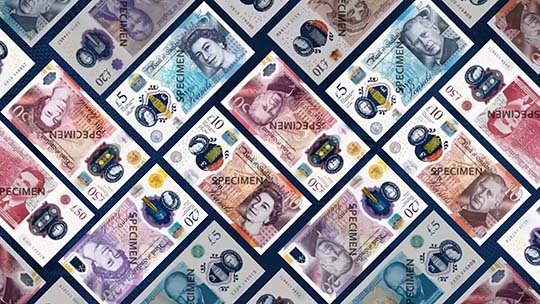Overview
You can see close-ups of all our banknotes, including details of their security features, in our banknote guides:
You can see close-ups of all our banknotes, including details of their security features, in our banknote guides:
This short film covers the key security features on all our current banknotes.

The Bank of England banknotes.
There are two versions of the banknotes in circulation. One version featuring a portrait of King Charles III and one version featuring a portrait of Her late Majesty, Queen Elizabeth II.
There are four denominations of the banknotes in circulation: £5, £10, £20 and £50.
All four denominations of notes are printed on polymer.
The security features are the same on both the King Charles III and Queen Elizabeth II notes.
This film will run through those key security features found on all the notes. You should check these features to ensure notes are genuine.
There is a large see-through window.
A clearly defined portrait of either King Charles III or Queen Elizabeth II is printed on the window with the numerical value of the note and the words ‘Bank of England’ printed twice around the edge.
A metallic image is positioned over the window.
The foil is gold on the front of the £5 and £10 notes; gold and blue on the front of the £20 note; and gold and green on the front of the £50 note. The foil is silver on the back of all notes.
On the £20 and £50 notes there is a second, smaller window in the bottom corner of the note.
Below the main see-through window on the front of all the notes, there is a silver foil patch containing a hologram. When you tilt the note from side to side, the words change between the value of the note and ‘Pounds’.
A 3D image of the coronation crown appears above the main see-through window.
On the back of the notes, directly behind the silver crown on the front, there is a metallic, foil patch.
The foil is green on the £5 note, copper on the £10 note, purple on the £20 note and red on the £50 note.
On the front of the notes, you can feel raised print. For example, on the words ‘Bank of England’ and in the bottom right corner.
Under a good quality ultra-violet light, the numerical value appears in bright red and green on the front of the notes, against a duller background.
The Bank of England banknotes.
You can also order our free education materials online
The training highlights the security features on our notes, which you can use to check your notes are genuine. We also offer advice and a short test to check your understanding. It takes approximately 30 minutes to complete.
Counterfeit banknotes are rare and also worthless.
We cannot reimburse you for counterfeit banknotes. If you suspect that you have a counterfeit banknote, please take it to your nearest police station. The police should fill out an NCO-1 form and provide you with a receipt and incident number. The suspect notes will be sent to the National Crime Agency and if counterfeit to the Bank of England for further examination.
If there is insufficient information to pursue an investigation or the circumstances are not suspicious then please return the notes to the Bank of England using one of these forms.
If notes are being sent directly in the post to the Bank of England by you, then use the Individual form.
If notes are being sent via a cash centre or a business head office and then to the Bank of England, then use the Business form.
An accessible version of these forms can be requested by emailing counterfeit@bankofengland.co.uk.
If you have information about someone making, selling or using counteIrfeit banknotes, please contact the police or phone Crimestoppers anonymously on 0800 555 111.
Counterfeiting directly funds organised crime. It hurts the UK economy by creating losses for businesses, which ultimately affects the cost of things that we buy. It also affects the pocket of anyone who receives a counterfeit note, as the notes are worthless. If you report counterfeiting to the police, you are helping with investigations and alerting them to a problem in their area. This means they can take action to protect your community.